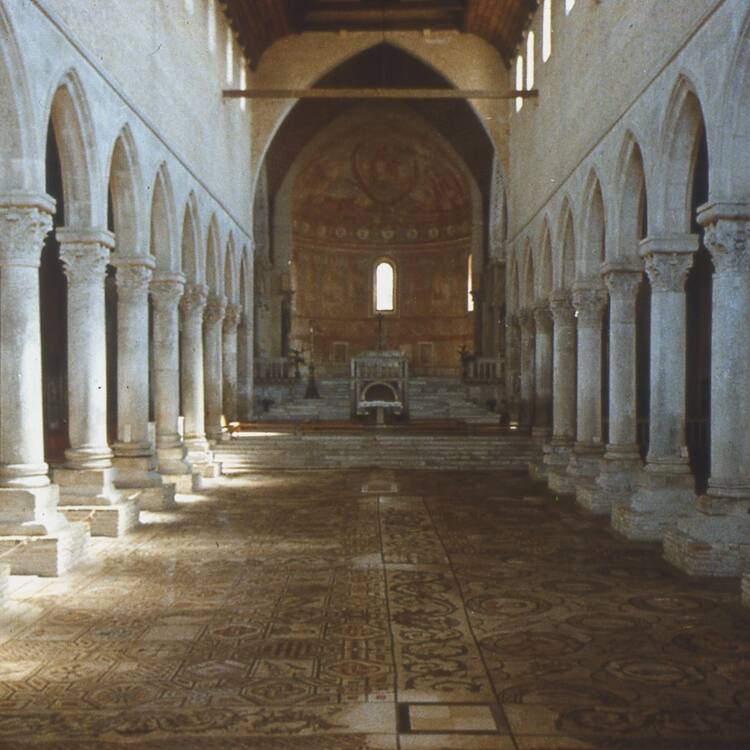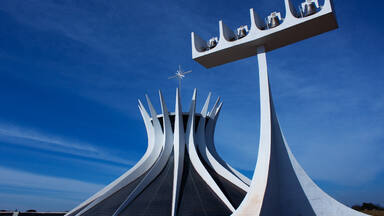Archaeological Area and the Patriarchal Basilica of Aquileia
Archaeological Area and the Patriarchal Basilica of Aquileia
Aquileia (in Friuli-Venezia Giulia), one of the largest and wealthiest cities of the Early Roman Empire, was destroyed by Attila in the mid-5th century. Most of it still lies unexcavated beneath the fields, and as such it constitutes the greatest archaeological reserve of its kind. The patriarchal basilica, an outstanding building with an exceptional mosaic pavement, played a key role in the evangelization of a large region of central Europe.
Description is available under license CC-BY-SA IGO 3.0
Zone archéologique et la basilique patriarcale d’Aquilée
Aquilée, dans la province du Frioul-Vénétie Julienne, fut l'une des villes les plus importantes et les plus riches du Haut-Empire avant d'être détruite par Attila au milieu du Ve siècle. La plupart de ses vestiges demeurent intacts sous les prairies environnantes, constituant ainsi la plus grande réserve archéologique de son espèce. Sa basilique patriarcale, avec son exceptionnel pavement de mosaïque, est un édifice remarquable qui a également joué un rôle essentiel dans l'évangélisation d'une grande partie de l'Europe centrale.
Description is available under license CC-BY-SA IGO 3.0
المنطقة الأثرية والبازيليك البطريركية في أكيليا
كانت أكيليا في محافظة فريول-فينيسيا جوليان إحدى المدن الأكثر أهمية وغنىً في الامبراطورية العليا قبل أن يدمرها أتيلا في منتصف القرن الخامس. فمعظم آثارها ما زالت سليمة تحت البراري المحيطة مشكّلةً المنطقة الأثرية المحفوظة الأكبر من نوعها. وتشكل البازيليك البطريركية برصيفها المميز المصنوع من الفسيفساء نصبًًا مذهلاً أدّى هو أيضًا دورًا بارزًا في تبشير جزء كبير من أوروبا الوسطى.
source: UNESCO/CPE
Description is available under license CC-BY-SA IGO 3.0
阿奎拉古迹区及长方形主教教堂
阿奎拉(位于意大利东北部地区弗留利威尼西亚朱利亚区)是早期罗马帝国最大最富有的城市之一,在5世纪中叶被阿提拉(Attila)匈奴帝国国王毁灭。阿奎拉大部分遗迹仍埋在地下而未被发掘,正由于此,它才是这一类型中最大的古迹区。这里的长方形主教教堂是用优质的马赛克铺筑的著名建筑,同时它也在中欧大部地区的传教过程中发挥了关键作用。
source: UNESCO/CPE
Description is available under license CC-BY-SA IGO 3.0
Археологические памятники и патриаршая базилика в Аквилее
Аквилея (в области Фриули – Венеция-Джулия), один из крупнейших и богатейших городов ранней Римской империи, была разрушена Атиллой в середине V в. Большая ее часть еще лежит нераскопанной под полями, представляя крупнейший резерв археологии. Патриаршая базилика – выдающееся здание с исключительными мозаичными полами - играла ключевую роль в христианизации этого крупного региона в Центральной Европе.
source: UNESCO/CPE
Description is available under license CC-BY-SA IGO 3.0
Zona arqueológica y basílica patriarcal de Aquilea
Situado en la región de Friuli-Venecia Julia, este sitio encierra los vestigios de Aquilea, que fue una de las ciudades más importantes y prósperas de la época del Alto Imperio Romano, antes de que fuese destruida por Atila a mediados del siglo V. La mayor parte de sus ruinas permanecen intactas, enterradas bajo los campos circundantes, lo cual hace de este sitio la mayor reserva arqueológica del mundo en su género. El notable edificio de la basílica patriarcal, ornamentado con un magnífico pavimento de mosaicos, atestigua la importancia de la Iglesia de esta ciudad, que desempeñó un papel esencial en la evangelización de una gran parte de Europa Central.
source: UNESCO/CPE
Description is available under license CC-BY-SA IGO 3.0
アクイレイアの遺跡地域と総主教聖堂バシリカ
source: NFUAJ
Archeologisch gebied en patriarchale basiliek van Aquileia
Source: unesco.nl
Outstanding Universal Value
Brief synthesis
Located at the northern end of the Adriatic Sea on the Natissa (Natiso) River, the property includes the Archaeological Area and the Patriarchal Basilica of Aquileia. The Roman city dates to 181 BCE and became one of the largest and wealthiest cities in the early Roman Empire until it was sacked and destroyed in 452 by the Huns led by Attila.
The city was a major trading centre connecting the Mediterranean to Central Europe. Aquileia’s wealth and status within the empire was reflected in its magnificent public buildings and private residences many of which survive as archaeological remains. The archaeological area, covering 155 hectares, includes part of the forum and its Roman basilica (courthouse), the late antique horrea, one of the sets of baths, and two luxurious residential complexes. Outside the late Roman city walls, the entire course of which has been located and part of which stills survives, excavations have also revealed a cemetery with some impressive funerary monuments. Below ground archaeological remains of the amphitheatre and the circus have also been preserved.
The most striking remains of the Roman city are those of the port installations, a long row of warehouses and quays that stretch along the bank of the river. These were incorporated into the 4th century defences, substantial traces of which can be seen today.
The dominant feature of Aquileia is the Basilica, erected, primarily, in the early-Christian period. The imposing mosaic floor dates back to the Theodorian church built at the beginning of the IV century and rebuilt between the 11th and 14th century according to the Romanesque and Gothic style.
Most of Aquileia remains unexcavated beneath fields and, as a result, constitutes a unique archaeological reserve. Its Patriarchal Basilica is an outstanding building that houses an exceptional work of art in its mosaic pavement and also played a key role in the evangelization of a large region of central Europe. It became the seat of a Patriarchate which survived until 1751.
Criterion (iii): Aquileia was one of the largest and most wealthy cities of the Early Roman Empire.
Criterion (iv): By virtue of the fact that most of ancient Aquileia survives intact and unexcavated, it is the most complete example of an Early Roman city in the Mediterranean world.
Criterion (vi): The Patriarchal Basilican Complex in Aquileia played a decisive role in the spread of Christianity into central Europe in the early Middle Ages.
Integrity
The World Heritage property includes all the elements contributing to justify its Outstanding Universal Value, encompassing the Patriarchal complex of the Basilica and the whole extension of the Roman city. Most of the archaeological area remains intact as it is located beneath the small contemporary town and large areas of agricultural land. It is, therefore, probably the largest unexcavated Roman city in the whole Mediterranean world, and as such its potential for research is enormous.
Threats identified for the property relate primarily to water damage caused by flooding and water table level. In addition, the impact of traffic on the highway main street passing through the property was identified at the time of inscription.
Authenticity
Archaeological work began in Aquileia in the late 19th century and has continued, since that time, hand in hand with conservation and minimal reconstruction work, associated with meticulous archaeological and art-historical research. Some of the restoration work carried out on excavated archaeological areas in the decades immediately preceding and following World War II, however, would not be considered acceptable by current standards. This work involved the reconstruction of colonnades using bricks to fill missing portions of columns and importing stone slabs for paving, work that exceeds current limits of acceptable anastylosis. A more rigorous policy is now in operation, involving minimal intervention.
As a result, the authenticity of the property is high. For example, most of the original city of Aquileia remains buried and unexcavated beneath the modern small town and agricultural land, the layout and form of the Roman city survives intact. The area continues to function as a small urban centre although Aquileia’s role as a major trading centre was replaced by Venice many centuries ago.
The Patriarchal Basilica has retained its religious function. The present building, with its cruciform layout, dates from the 9th century although its foundations are from the Roman period. Its original Romanesque style has largely survived impacted only by Gothic features that reflect a reconstruction programme following a mid-14th century earthquake.
Most of the work undertaken at the Basilica has followed the principles of the Charter on the Conservation and Restoration. Moreover, the restoration and conservation of the mosaic floors in the interior and the restoration of the baptistery have been done following the strictest conservative criteria.
Protection and management requirements
The entire area inscribed on the World Heritage List is protected under the Legislative Decree 42/2004, Code of Cultural Heritage and Landscape a safeguarding measure which ensures that any activity on the site must be authorized by the relevant Superintendence (peripheral office of the Ministry for Cultural Heritage and Activities).
Ownership is shared between the Italian State (excavated areas, museums), the Roman Catholic Church (the Basilica complex), the Municipality of Aquileia, and private individuals.
The urban planning (called Piano Regolatore Generale-PRG) refers specifically to the cultural importance of the property and reinforces the limitations provided by the legislative protection.
Overall responsibility for supervision of the protection by legislation rests with the peripheral offices of the Ministry for Cultural Heritage and Activities, based in Trieste, which manages the archaeological sites and museums. A comprehensive plan for the management of the properties has been prepared and this provides for regular conservation projects and also special research and restoration activities. The Church authorities manage the Basilican complex and have a detailed programme of conservation and restoration activities. The municipality actively controls all activities within its competence. It is worthy of comment that it is very supportive of all activities designed to extend the protection and presentation of its heritage.
Since 2008, beside municipality and the Superintendence, the Fondazione Aquileia has been involved in the management of the property The Fondazione is a juridical body established jointly by the Ministry, Region Friuli Venezia Giulia, Municipality of Aquiliea, and Province of Udine with a principal mission focused on strategic planning for cultural development and general suggestions for territorial activities relating to the management of the property. Fondazione Aquileia manages some areas assigned by the Ministry, for valorization, conservation, and restoration.


